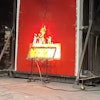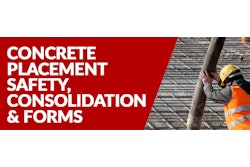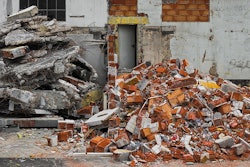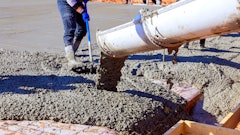
Did you know concrete formwork represents close to half the cost of a concrete structure? With proper care and maintenance, APA-trademarked concrete form panels provide reliable and consistent performance on job after job. Ensure you are getting the most out of your concrete forms—and your budget—with these simple panel care recommendations.
Stripping: Metal bars or pry bars should not be used on plywood because they will damage the panel surface and edge. Use wood wedges, tapping gradually when necessary. Plywood’s strength, lightweight and large panel size helps reduce stripping time and the cross-laminated construction resists edge splitting.
Cleaning and Release Agent Application: Soon after removal, plywood forms should be inspected for wear, cleaned, repaired, spot primed, refinished, and lightly treated with a form-release agent before reusing.
Handling & Storage: Care should be exercised to prevent panel chipping, denting, and corner damage during handling. Panels should never be dropped. The forms should be carefully piled flat, face-to-face and back-to-back, for hauling. Forms should be cleaned immediately after stripping and can be solid-stacked or stacked in small packages, with faces together. This slows the drying rate and minimizes face checking. Plywood stack handling equipment and small trailers for hauling and storing panels between jobs will minimize handling time and damage possibilities. During storage, the stacks of plywood panels should be kept out of the sun and rain or covered loosely to allow air circulation without heat build-up.
Coating & Agents: Protective sealant coatings and release agents for plywood increase form life and aid in stripping. “Mill-oiled” Plyform® panels may require only a light coating of release agent between uses. Specifications should be checked before using any release agent on the forms. Plywood form coatings, such as lacquers, resin or plastic base compounds, and similar field coatings sometimes are used to form a hard, dry, water-resistant film on plywood forms. In most cases, the need for the application of release agents between pours is reduced by the field-applied coatings.
Effect of Admixtures on Forming Panels: Admixtures are chemicals added to a concrete mix to change the properties of a basic mix of cement, water, and aggregate. They can speed or retard setting times, increase workability, increase air content, decrease water permeability or increase strength among other effects. Admixtures include pozzolans such as silica fume, blast-furnace slag, and fly ash. The use of admixtures is relatively common and many of these additives increase the abrasiveness and/or alkalinity of the concrete. While wood and phenolic overlays are resistant to alkaline solutions and abrasion, the use of admixtures may significantly decrease the “normal” life of a concrete-forming panel.
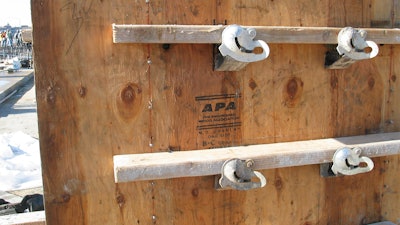 The APA trademark signifies the manufacturer’s commitment to a rigorous program of quality verification and testing.APA - The Engineered Wood Association
The APA trademark signifies the manufacturer’s commitment to a rigorous program of quality verification and testing.APA - The Engineered Wood Association
Frequently Asked Questions
What's the biggest difference between APA-trademarked concrete forming panels over imported?
APA-trademarked concrete form panels are manufactured to stringent product standards (such as Voluntary Product Standard PS 1, Structural Plywood, and Voluntary Product Standard PS 2, Performance Standard for Wood Structural Panels) and are subject to APA's rigorous, state-of-the-art quality verification and testing programs.
Many imported forming panels do not undergo comparable product qualification testing. Without such tests, it’s impossible to determine how the panel will perform for the intended use. As an internationally accredited testing laboratory, APA put imported hardwood plywood panels from China and Brazil up against domestic plywood certified to the U.S. Product Standard PS 1. The import test results indicated inferior mechanical and connection properties and severe failure for bond durability. Only one tested sample would have met the formaldehyde limits imposed by the California Air Resources Board and U.S. Environmental Protection Agency.
Look for concrete forming panels bearing the APA trademark. It appears only on products manufactured by APA members committed to APA's rigorous program of quality inspection and testing.
Where do I find APA-trademarked concrete forming panels?
APA-member manufacturers are located throughout North America. Hundreds of distribution centers throughout the U.S. and Canada inventory a wide selection of concrete-forming panels and engineered wood products. The APA provides a complete list of members manufacturing concrete-forming panels at www.performancepanels.com.
What is O & ES or OES?
Oiled and edge-sealed. Surfaces of concrete form panels are lightly coated with oil and the edges sealed if specified.
How many pours can I get out of a sheet of concrete forming plywood?
Many factors affect the number of pours expected from a sheet of concrete forming plywood, including the expected finish on the concrete, the overlay (if any), the concrete mix, maintenance, and care. Up to 10 pours can be expected from a B-B grade non-overlaid panel. With reasonable care, HDO Plyform will normally produce 20 to 50 reuses or more. Consult with your supplier for advice on maximizing the number of pours.
About the author
Warren Hamrick is an Engineered Wood Specialist for APA – The Engineered Wood Association. Hamrick consults with and conducts workshops for designers, code officials, and other building professionals on best practices for specification, selection and application of engineered wood products. He graduated from North Carolina State University with a Bachelor of Science in Civil Engineering.



